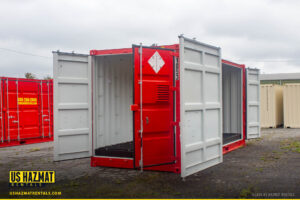‘Paging Dr. Compliant Chemical Storage….. Hello? Can the good doctor return to the emergency room immediately?’ While you’re unlikely ever to hear this urgent plea awaiting reliable medical care at the hospital, the need for reliable, safe chemical storage speaks volumes in the medical industry following a recent chemical spill at a Ventura County, California hospital. A hazmat team quickly responded to a chemical spill in the operating room last week, causing an immediate evacuation of physicians, nurses, and harried patients. Imagine trying to recuperate from your perilous state in the hospital, only to be quickly scuttled out of the building as another imminent threat descends upon your medical refuge. Dr. House himself would be left promptly thumbing through the medical reference book, looking for a novel and creative solution. Although medical emergencies never lack interventive drama in the OR, a toxic chemical spill can spike the EKG before flatlining the operation.
“A hazardous materials spill involving approximately half a gallon of formaldehyde has occurred in an operating room,” the Ventura County Fire Department’s public information officer posted on X, formerly Twitter. “Hazmat-trained firefighters are preparing to enter the affected area.”
The Dangers of Noncompliant Hospital Chemical Storage

While it might defy the traditional logic of recuperative medical care, hospitals store dangerous chemicals that pose inherent risks to recovering patients. Sanitation and cleanliness are paramount at hospitals and other medical facilities. Hospitals rely on powerful cleaning and disinfecting agents to prevent cross-contamination in the lab and in patients’ rooms. Work surfaces and instruments must be repeatedly sterilized between procedures. Impertinent or obstinate patients, particularly, could feel the ill effects of noxious gases and anesthetic chemicals if medical malpractice is afoot, and mercury from medical diagnostic chemicals could breach otherwise pristine working conditions if not correctly stored and maintained. Hydrochloric acid, a common and powerful disinfectant for fungi and viruses and welcomed ancillary aid for ophthalmic solutions, must also be closely monitored, as with critically wounded patients in the intensive care unit.
Fire-rated Hazmat Solution for Medical Cleaning Supplies

Housekeeping is the Florence Nightingale of modern medicine. Without their anticipatory vigilance in response, even the most sophisticated medical facilities would be teeming with dangerous bacteria and contagion. But routine maintenance and oversight comes at a tremendous cost. According to Definitive Healthcare, the average cost of housekeeping across all U.S. hospitals was $2.6 million. Like exorbitant and delayed federal medical reimbursements, wanton waste plagues thousands of hospitals nationwide as the aforementioned disease practitioners work tirelessly to eradicate from post-pandemic beleaguered communities. The average American hospital wastes approximately $100,000 annually on unused medical supplies. Considering these tedious recurring expenditures, shouldn’t hospitals invest in federally compliant chemical storage for disinfectants and medical supplies?
Our fire-rated chemical storage lockers can safely store large volumes of powerful medical disinfectants and cleaning supplies at any typical medical facility without compromising the strict flow of operations crucial in life-and-death scenarios. Each standard steel-gauge locker is reinforced with solid-steel sheeted halls and innovative explosion-relief paneling to mitigate potential risks with daily sanitation services and procuring volatile yet necessary disinfectants. Firmly affixed spill sump containment systems will also prevent accidental chemical spills, such as the formaldehyde incident in Ventura County. Compartmentalized and central hospital chemical storage can also reduce unnecessary waste while store vulnerable chemicals and equipment in a climate-controlled environment. Keep your patients safe and protected without compromising your staff’s diligence in delivering optimal patient outcomes by investing in compliant chemical storage from U.S. Hazmat Storage.


